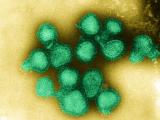Jan 14, 2011 (CIDRAP News) – The US Centers for Disease Control and Prevention (CDC) said today that, although some influenza indicators dropped during the previous week, more states are reporting widespread flu activity, and it is unlikely that flu activity has already peaked.
Doctor's visits for flu-like illnesses dipped again slightly for the second week in a row, from 2.6% to 2.2%, which puts the level below the national baseline. The southeastern region is the only area that is still above its baseline.
The percentage of respiratory samples that tested positive for flu also dropped for the second consecutive week, from 21% to 16%.
Eleven states reported widespread influenza activity, up from eight reported the previous week. One more state reported regional flu activity, raising that total to 17.
"Although influenza activity can rise and fall during an influenza season, activity in the United States generally peaks in January or later in most years," the CDC said in a summary of its weekly surveillance update.
Hospitalization rates for flu and deaths from pneumonia and flu are at expected levels for this point in the flu season, the CDC said.
Four pediatric deaths were reported, two from influenza A (H3N2) and two from influenza B, which raises the total from all flu strains to eight for the season.
About 74% of viruses were influenza A—most of it H3N2—with 26% of subtyped samples showing evidence of influenza B.
The CDC said the circulating viruses are still a good match to the vaccine's three strains and remain susceptible to oseltamivir (Tamiflu) and zanamivir.
In other developments, the CDC today sent a Health Alert Network message to clinicians reminding them of updated guidance on antiviral drugs and rapid influenza tests, given that flu activity has become more widespread.
The CDC urges early empiric antiviral treatment for people at high risk for flu complications and those who are hospitalized or have severe, complicated, or progressive illness. It added that antiviral s can be considered, based on the clinician's judgment, for previously healthy patients with suspected or confirmed infections if treatment can be started within 48 hours of illness onset.
Antiviral medications can be used in children younger than 1 year, and clinicians should keep abreast of local flu circulation patterns and findings from patients who have suspected infections, the CDC emphasized.
An interim version of the updated antiviral guidance appears on the CDC's Web site, and it will also be published in an upcoming issue of Morbidity and Mortality Weekly Report.
Highlights of the CDC's rapid influenza test recommendations include using them when a finding will guide clinical decisions and may help determine outbreak control strategies. Because the tests lack sensitivity, the CDC said negative test results should not be used to make antiviral medication decisions.
The alert also said that further laboratory testing should be considered when a patient tests negative on a rapid test during periods of high flu activity, a patient's rapid test is positive when flu activity is low, and a patient was recently exposed to pigs, poultry, or other animals and a novel influenza A infection is possible.
See also:
Jan 14 CDC flu update summary
Jan 14 CDC FluView
Jan 14 CDC Health Alert Network message




















